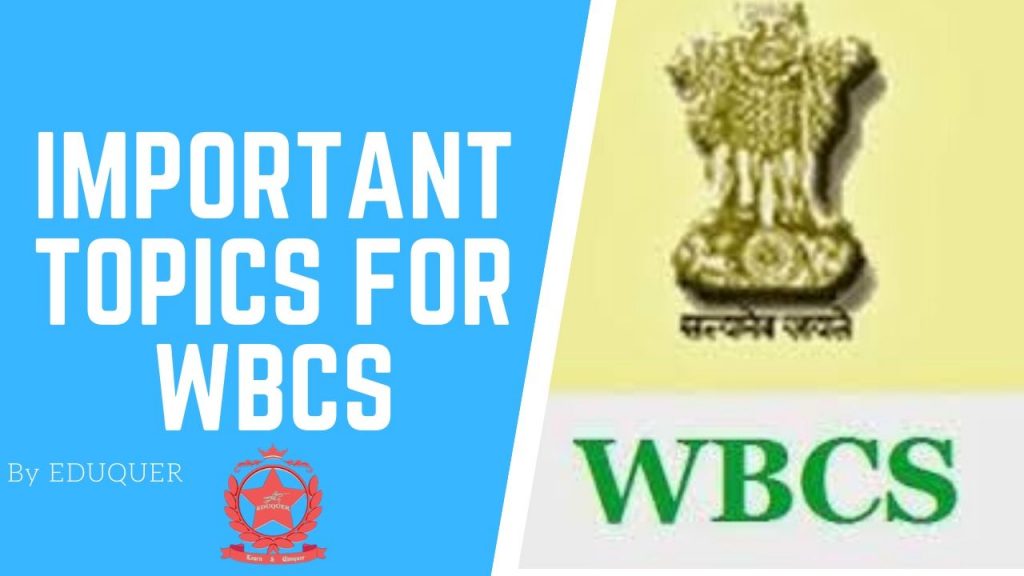Table of Contents
PAPER-I
ENGLISH
- Letter writing (within 200 words)
- Drafting of Report (within 200 words)
- Précis Writing
- Composition and Translation (from English to Bengali/Hindi/Urdu/Nepali/Santali)
Important topics: Environmental problems, woman empowerment, children related problems, social problems, govt. schemes, bills, acts, etc.
PAPER-II
BENGALI
- Letter writing (within 200 words)
- Drafting of Report (within 200 words)
- Précis Writing
- Composition and Translation (from Bengali/Hindi/Urdu/Nepali/Santali to English)
Important topics: Environmental problems, woman empowerment, children related problems, social problems, govt. schemes, bills, acts, etc.
PAPER-III
GENERAL STUDIES -I (HISTORY)
INDIAN HISTORY
1. Indus Valley civilization
– Society, Religion
– Important Harappan towns & artifacts excavated
– Extension
– Town Planning
– Economical Importance
– Political Life
– Causes of decline
2. Aryan Civilization
– Origin
– Vedic literature
– Religion
– Society
– Polity
– Economic Condition
– Difference between Indus and Aryan
3. Religions movements
Jainism
– About Mahavira & teachings
– councils
– Important books cause for the decline
Buddhism
– Buddha teachings
– Councils
– Important books
– Causes for decline
4. The Mauryan Empire
– About Ashoka in detail
– Article and Architecture
– Administration
– Society
5. Central Asian contacts and their results.
– Indo- Greeks
– The Shakas
– The Parthians Article and Architecture
– The Kushans – Kanishka in detail
6. South Indian History
– Sangam Age
– Satavahanas
– Chola’s
– Pallavas art and architecture
7. Gupta Empire
– Administration
– Article and Architecture
– Social development
8. Post-Gupta period
– Harsha in detail
– Feudal System
MEDIEVAL HISTORY
1. Turkish Invasion
– In detail
2. Delhi Sultanate
– Rulers and their contribution
– Aibek, Iltumish, Balban, Alauddin Khilji, Mohamad bin Tughlug, Feroz Tughlug, Sikandu Lodi, Ibrahim Lodi in detail
– Administration (Important terms)
– Art and Architecture
3. Vijayanagar Empire
– Krishna Devaraya in detail
– Important temples and books
4. Mughals
– Babar’s wars
– Akbar in detail
– Jehangir, Shahjahan, Aurangazeb in detail
– Administration
– Society
– Causes for decline
– Important books (authors)
– Art and Architecture
MODERN INDIAN HISTORY
1. Marathas
– Shivaji in detail
– Administration
– Peshwas and their administration
2. European powers
– Chronological order of European powers in India
– East India Company
– Important Governor-General and their contribution
Warren Hastings, Cornwallis, Wellesley, William Bentinck, Dalhousie, Lytton, Rippon, Curzon, Mount Patten.
– British rule impact on India
– Social and cultural developments/Awakening
3. Reform movements
– In detail
– Founders and their contribution
– Books
4. 1857 Revolt
– In detail
5. Freedom Struggle
– Formation of INC.
– Moderates and Extremist
– Partition Role of Bengal/Surat Split
– Muslim league
– Lucknow Pact
– Minto Morley/Montagu Chelmsford
6. Gandhian Era
– His experiments
– Non-Cooperation Movement
– Civil disobedience movement
– Gandhi – Irwin Pact
– August Offer
– Quit India Movement
– Cripps mission
– Cabinet Committee
– Partition
7. Indian National Congress
– INC meetings and its resolutions
– President, place
8. Extremist
– Terrorist activities
– Bengal
– Maharastra
– Some other places
9. Subash Chandra Bose
– INA formation in detail
GENERAL STUDIES -I ( GEOGRAPHY)
INDIAN GEOGRAPHY
- Basics of India
- Location, latitude, longitude, time zone, etc.
- Neighbours
- Important straits
- States and their position
- States with international boundaries
- Physical features
- The Himalayas – geological formation, climate, vegetation, soil, biodiversity, physiographic divisions, major passes, significance
- The Great North Indian Plains – geological formation, physiographic divisions, climate, vegetation, soil, biodiversity, significance
- Peninsular Plateau – geological formation, Central Highlands, Deccan Plateau, Western Ghats, Eastern Ghats
- Indian Desert
- Coastal plains and islands
- River systems
- Himalayan rivers
- Peninsular rivers
- River basins
- Regional development and planning
- Hydropower projects, major dams
- West-flowing and east-flowing rivers
- Interlinking of rivers
- Climate
- Monsoons – driving mechanism, El Nino, La Nina
- Seasons
- Cyclones
- Minerals and industries – mineral distribution, industrial policies, location
- Agriculture
- Land utilization
- Types of agricultural practices
- Green revolution
- Soils and crops
- Irrigation
- Land reforms
- Animal husbandry
- Government schemes
- Natural vegetation and fauna
- Classification of natural vegetation
- Rainfall distribution
- Biosphere reserves, national parks, etc.
- Red-listed species
- Economic infrastructure
- Transportation (highways, inland waterways, etc.)
- Power and energy sector
- Conventional and non-conventional sources of energy
- Energy conservation
- Human Geography
- Demographics
- Recent census
PAPER-IV
GENERAL STUDIES -II
SCIENCE AND TECH
A. Physics
4. Gravitation
B. Chemistry
C. Biology
10. Plant Hormones
12. Control and Coordination in Human.
13. Human Reproductive system.
14. Excretory system in Humans.
15. Respiratory system in Humans.
16. Human Circulatory system.
17. The Heart.
18. Composition of Blood.
19. Functions of Blood.
20. Human Digestive system.
21. Cell Division
ENVIRONMENTAL SCIENCE
GENERAL KNOWLEDGE
CURRENT AFFAIRS
4.Government schemes
5. Deaths
6. Head of the various organizations
7.Important summits
8.Appointments
9.Defence exercises
10.Space missions
PAPER-V
THE CONSTITUTION OF INDIA & INDIA ECONOMY + RBI
THE CONSTITUTION OF INDIA
1.The Preamble of the Constitution.
2.Union and its Territory.
3.Citizenship.
4.Fundamental Rights.
5.Directive Principles of State Policy.
6.Fundamental Duties.
7.President.
8.Vice-president.
9.Prime Minister, CoM, and Attorney General.
10.Parliament.
11.Supreme Court.
12.Governor.
13.Chief Minister and CoM.
14.State Legislature.
15.Local Self Government
16.Policies, Bills and Acts
17.Governance
18.Social Justice
19.Indian Polity: Recent Issues
20.Amendments
21.Important cases
THE INDIAN ECONOMY
- Characteristics of the Indian Economy
- Agriculture and land development
- National income
- Planning
- Unemployment
- Trade & commerce
- New income policy
- Indian financial system
- Indian fiscal system
- Banking in India
- TAX system
- Industry
- Foreign Trade
- Current issues
- Functions of the Reserve Bank of India.
PAPER-VI
ARITHMETIC AND TEST OF REASONING
ARITHMETIC
- Number System
- Fractions and Decimals
- Square roots
- Percentage
- Profit, Loss and Discount
- Ratio & Proportion
- Average
- Partnership Business
- Time and Distance
- Time and Work
- Pipes and Cisterns
- Mixture and Alligation
- Simple Interest & Compound Interest
TEST OF REASONING
- Analogy
- Odd pair
- Missing characters
- Coding-Decoding
- Seating arrangement
- Blood relations
- Ranking
- Direction Sense
- Venn Diagrams
- Assumption or Inference or Conclusion
- Clock
- Calendar
- Cube and dices
- Matrix (Finding missing numbers or letters)

